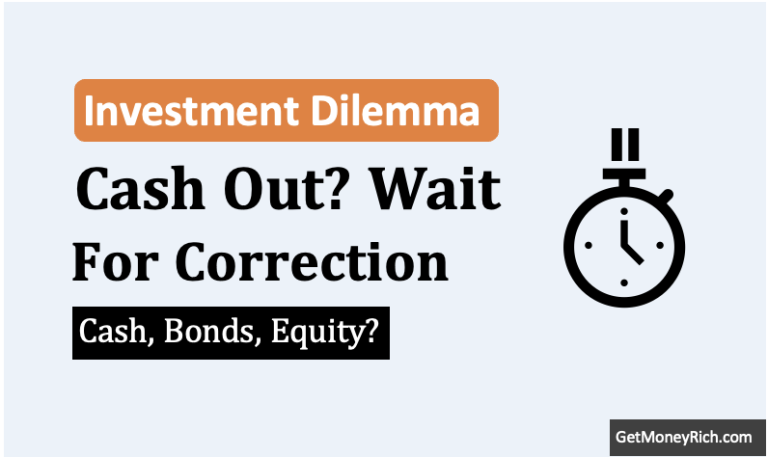Arithmetic vs. Geometric Returns Calculator
Calculate how volatility impacts your investment returns, starting with ₹1,00,000.
Tip: The gap between arithmetic (simple average) and geometric (actual) returns is most noticeable with volatile returns, like +20% and -10%. Try mixed returns instead of all positive or all negative to see the difference.
Results
Arithmetic Average Return: 0%
Geometric Annualized Return: 0%
Final Portfolio Value: ₹1,00,000
Remark: Enter returns and click Calculate to see how volatility impacts your investment.
Example How To Use The Calculator
We’ll take the example of ABSL Nifty 50 ETF. In the last 10 Years, this scheme has generated the following returns (year wise). To enter these values in the calculator, enter “10” in the field called “Number of Years (1-10).” Then, click the button called “Update years.” Then start entering the return data of each year (as shown in the table). Once all the numbers are entered, click on the button “Calculate Returns.“
| Year | FY | Return (%) |
| 10 | 2015 | -2.54 |
| 9 | 2016 | 4.63 |
| 8 | 2017 | 29.72 |
| 7 | 2018 | 4.36 |
| 6 | 2019 | 13.15 |
| 5 | 2020 | 15.77 |
| 4 | 2021 | 25.51 |
| 3 | 2022 | 5.67 |
| 2 | 2023 | 21.28 |
| 1 | 2024 | 9.90 |
For the above set of values, my calculate will render the following result:
- Arithmetic Average Return: 12.75%
- Geometric Annualized Return: 12.32%
- Final Portfolio Value: Rs.3,19,662 (Initial investment Rs.1 Lakh)
- Remark: Your returns show moderate volatility (std dev: 10.33%). The geometric return (12.32%) is lower than the arithmetic average (12.75%) because ups and downs reduce your actual growth. Try more extreme swings to see a larger difference.
Table of Contents
Introduction
Have you ever looked at your mutual fund’s “average” return and wondered why your actual gains don’t add up? This is a common disparity majority people face.
Many Indian investors expect their portfolios to match those neat 18-20% annual returns promised in brochures. But reality often disappoints.
Why does this happen?
It’s not just about market ups and downs. It’s about math, timing, and our own minds playing tricks on us.
Let’s under this topic with clarity so that in future we know what kind of returns to expect from our investments.
1. The Misleading Math of Average Returns
When you hear “average return,” what comes to mind?
Probably a straightforward number, right? But averages can be deceptive.
There’s a difference between arithmetic and geometric returns. Note: When we calculate returns, we generally do arithmetic calculations. But in practical life, the returns that we get are geometric returns.
Let me explain.
Arithmetic return is just the average of yearly gains and losses.
- Say your stock gives +20% one year and -10% the next.
- The arithmetic average is (20 – 10) / 2 = 5%.
Its simple, right?
But there is a catch in this mathematics. Your actual wealth will not grow by 5%. How?
Check the next example of geometric return.
Geometric return considers compounding and volatility.
- Imagine you invest Rs.1 lakh.
- A 20% gain makes it Rs.1.2 lakh [=1*(1+20%)].
- A 10% loss from the top drops your wealth to it to Rs.1.08 lakh [=1.2*(1-10%)].
- Your actual return over two years? Just 3.9% per year, not 5%.
Volatility eats into your gains. The more the market swings, the bigger the gap between arithmetic and geometric returns.
This is why those “average” numbers in fund factsheets don’t tell the full story.
Note: The difference between arithmetic and geometric returns becomes significant only when returns are volatile, especially when they swing between positive and negative values. In a consistently rising or falling markets, both arithmetic and geometric returns will be almost same.
Example #1
Let’s calculate the arithmetic return and geometric return of the following set of numbers:
| Year | Return | Value | Return in Decimal |
|---|---|---|---|
| 0 | N/A | 1.000 | N/A |
| 1 | 12% | 1.120 | 0.12 |
| 2 | 15% | 1.288 | 0.15 |
| 3 | 16% | 1.494 | 0.16 |
| 4 | 20% | 1.793 | 0.20 |
| 5 | 19.95% | 2.151 | 0.1995 |
- Arithmetic Return Calculation: (0.1200 + 0.1500 + 0.1600 + 0.2000 + 0.1995) / 5 = 0.1659 = 16.59
- Geometric Return Calculation: (Ending Value / Beginning Value)^(1/n) – 1 = (2.151/1)^(1/5) – 1 = 16.45%
Example #2
| Year | Annual Return | Value | Return in Decimal |
|---|---|---|---|
| 0 | N/A | 1 | N/A |
| 1 | +100% | 2 | 1.00 |
| 2 | -50% | 1 | -0.50 |
| 3 | +100% | 2 | 1.00 |
| 4 | -50% | 1 | -0.50 |
- Arithmetic Return Calculation: (1 – 0.5 + 1 – 0.5) / 4 = 1/4 = 0.25 = 25%
- Geometric Return Calculation: (Ending Value / Beginning Value)^(1/n) – 1 = (1/1)^(1/4) – 1 = 0%
2. Sequence of Returns: Timing Can Hurt
Ever thought about when your losses hit? Timing matters, especially if you’re withdrawing money, like in retirement. This is called sequence of returns risk.
Let’s see real numbers to understand the impact.
Picture two retirees, Priya and Sanjay.
- Both of them have a Rs.1 crore in savings.
- Both expect a 6% average return over 20 years.
- They withdraw Rs.5 lakh yearly for expenses. Their returns are the same, say, +12%, -10%, -8%, and so on, but in a different order.
There in one difference for us to note: Priya gets hit with losses early, Sanjay later.
- For Priya:
- A -10% drop in year one shrinks her Rs.1 crore to Rs.90 lakh.
- Withdrawing Rs.5 lakh now takes a bigger chunk, 5.56% of her portfolio (remaining portfolio is now Rs.85 Lakhs
- Now, the portfolio goes up by say +12%. The size of the portfolio inflates and become Rs.87.6 Lakhs.
- From this level, a -8% decline will bring the corpus to Rs.80.6 Lakhs.
- For Sanjay:
- He had some early gains. Hence, when he starts withdrawing he is doing it from a larger base. So, losses later hurt less.
- Sanjay say a gain of +12% in year one itself. His Rs.1 crore became Rs.1.12 crore.
- Now, he withdraws Rs.5 lakh. This withdrawal is only 4.46% of his portfolio (remaining portfolio is now Rs.1.07 crore.
- Form this corpus size the portfolio first slips by -10% bringing it to Rs.96 Lakhs.
- Now, again the portfolio slips by -8% bringing the size of corpus down to Rs.88.6 Lakhs.
So you can see, Same starting point, same average returns, but Priya has Rs.8 lakhs less than Sanjay.
Scary, isn’t it? This shows why the sequence of returns can make a big difference in our portfolio size.
3. Our Minds Are the Real Culprit
Even if you understand the math, your brain can sabotage you.
Behavioural finance explains why we make bad money decisions.
Let’s talk about a few traps we Indians often fall into.
- First, loss aversion. Losing Rs.10,000 hurts more than gaining Rs.10,000 feels good. Remember the 2020 market crash? Many sold their SIPs in panic, only to miss the recovery.
- Second, recency bias. We think recent trends will continue forever. A bull run tempts us to pour money in at the peak. A crash makes us hide in fixed deposits. This is a mistake. We should act in reverse. Invest when the market is down and keep money in FD when market seeing peaks.
- Third, market timing. We try to buy low, sell high, but end up doing the opposite. Studies show the average equity investor earns less than the Nifty 50 because of the these mistimed moves.
These biases turn a solid plan into a mess.
Ever sold a stock too early or held a loser too long? That’s your brain telling you to do the opposite from what is right. This is why, though stock market feels like an easy place to be, considering our psychological limitations, it is far more difficult for a common men to make money from it.
4. How to Bridge the Gap
So, how do we beat these traps? It’s not just about picking better funds.
It’s about managing expectations and emotions.
Here are some practical ideas.
- Bucketing Your Money: Think of your portfolio as buckets for different needs. Keep 1-3 years of expenses in safe options like FDs or liquid funds. Money for 3-7 years can go into hybrid funds. Long-term goals? Equity funds. This way, you don’t sell stocks in a crash, protecting you from sequence risk.
- Flexible Withdrawals: If you’re retired, don’t withdraw a fixed amount blindly. Use a dynamic strategy. In bad years, cut withdrawals slightly, say, from 5% to 4%. In good years, take a bit more. This keeps your savings healthier for longer.
- Add Some Guarantees: Consider products like annuities for steady income. If an annuity pays Rs.3 lakh yearly, you rely less on your stock portfolio during market dips.
5. A Lesson from My Uncle’s SIP
Let me share a story.
My uncle started a SIP in an equity fund years ago, expecting 12% returns based on the fund’s average.
But a few bad years early on left him jittery. He almost stopped his SIP during a market dip, fearing losses.
I sat him down, explained sequence risk, and suggested keeping a cash buffer for emergencies.
He stuck with it. Today, his portfolio’s doing well, but he still talks about that moment of doubt. It’s a reminder that our emotions can derail even the best plans.
Conclusion
Those “average” returns you read about? They’re not what you get.
Volatility, bad timing, and our own biases create a gap between theory and reality.
Geometric returns show the true picture. Sequence risk can hurt, especially when withdrawing. And our mind, well, they’re wired to make things harder.
But you can fight back.
Use bucketing to stay calm during market swings. Adjust withdrawals based on performance. Maybe add an annuity for stability.
Most importantly, know your biases.
Next time you’re tempted to sell in a panic or chase a hot stock, pause. Ask yourself, is this my plan talking, or my emotions?
Quick recap of what we’ve learnt:
- Arithmetic averages mislead; geometric returns show reality.
- Sequence of returns risk matters when you withdraw.
- Watch out your psychology (loss aversion, recency bias, and market timing).
- Use bucketing, flexible withdrawals, or annuities to stay on track.
Have a happy investing.

![ROI Formulas: CAGR and XIRR, Meaning, Full Form, Use in Excel [Mutual Funds]](https://ourwealthinsights.com/wp-content/uploads/2018/04/How-to-measure-investment-returns-Image.jpg)




